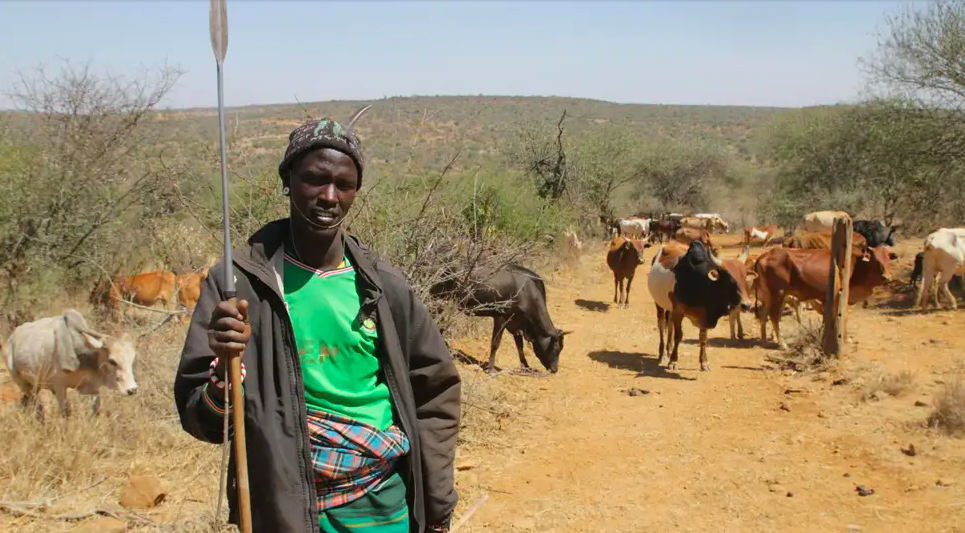Bringing conservation’s benefits to local people pays off
Projects including modern cattle enclosures to keep livestock safe from lions wins locals’ support

By Evelyn Makena for People Daily in Kenya
It’s hardly what you expect to see. Deep in a protected wildlife area beside Kenya’s famed Masai Mara National Reserve, cows nonchalantly graze amidst impalas, zebras and gazelles just within easy reach of predators that roam the natural wilderness.
When darkness falls, to keep safe, the cows retreat to simple metallic enclosures that are a modern version of the Masai people’s thorn-bush enclosures called ‘bomas’.
These new fortified bomas adopted by the Mara Conservancy have proved successful in deterring lion attacks on livestock. That deters retaliatory killings of the big cats by the cows’ owners.
The bomas are an improved version of traditional Masai cow pens, usually fenced with acacia thorns and dry twigs. Traditional bomas have spaces in between and are not safe enough to keep lions, hyenas and leopards from preying on livestock.
When this happens, livestock owners retaliate by killing predators contributing to the decline of the big cats particularly, the lion.
“Mara North [a neighbouring conservancy], which has a herd of over 200 cows, has set up the fortified bomas to demonstrate to the community that wildlife and livestock can peacefully coexist,” says Daniel Ole Muli, the regional coordinator of the Masai Mara Wildlife Conservancies Association, the umbrella body of 14 conservancies within the greater Masai Mara ecosystem.
Joseph Nabaala, Aitong area chief, says competition for resources between human and wildlife due to rapid population growth and climate change has fueled rampant human-wildlife conflict.
Planting chilli fences and beekeeping have particularly proved effective in warding off elephants that stray into nearby farms and destroy crops.Elephants are afraid of bees due to their painful sting and their buzzing sound. They also cannot stand chillies because the irritant causes them to cough and sneeze.
Within the greater Masai Mara ecosystem - the area outside the National Reserve - local communities have partnered with wildlife conservationists to protect crucial wildlife habitats.
Members of the community lease their land to the conservancies and benefit from a guaranteed monthly income, employment opportunities and improved revenues from tourism.
Engaging the communities in activities that help tackle human-wildlife conflict by finding a balance between conservation and supporting livelihoods has been vital in ensuring peaceful coexistence.
This community-led conservation model adopted by the Masai Mara conservancies struck a chord with a delegation of Zambian conservation representatives who were in Kenya recently.
The delegation of government officials, traditional leaders and conservation representatives was interested in seeing best practices of community conservation.
“Operational community conservancies in Zambia are few, while others that are there, are in their infant stages,” says His Royal Highness Chief Mujimanzovu of the North Western region of Zambia.
Unlike in Kenya, where the main land tenures are state and private, in Zambia land is under the state and customary leadership. Traditional leadership is pronounced in Zambia with over 300 chiefdoms across the country under who’s the custodian of the biggest chunk of land lies.
Although most of the wildlife-protected areas are under customary land, they are controlled by the government, which makes the process of forming conservancies long.
Through the support of The Nature Conservancy, a global conservation organisation that works in several African countries including Zambia and Kenya, several conservation bodies in Zambia are in the process of forming conservancies around key wildlife habitats, to increase community involvement in wildlife conservation and secure livelihoods.
The Nature Conservancy has been working with conservation stakeholders around Kafue National Park, the largest in Zambia, to address threats such as poaching, wildfires and environmental degradation.
According to Victor Siamudaala, The Nature Conservancy’s Zambia country director, the best community conservation practices learnt in Kenya will offer powerful insights that could help inform the process of forming new conservancies in Zambia.

This article is reproduced here as part of the Giants Club African Conservation Journalism Fellowships, a programme of the charity Space for Giants and supported by the owner of ESI Media, which includes independent.co.uk. It aims to expand the reach of conservation and environmental journalism in Africa, and bring more African voices into the international conservation debate. Read the original story here
Join our commenting forum
Join thought-provoking conversations, follow other Independent readers and see their replies
Comments
Bookmark popover
Removed from bookmarks